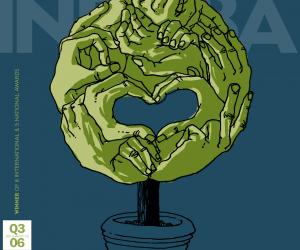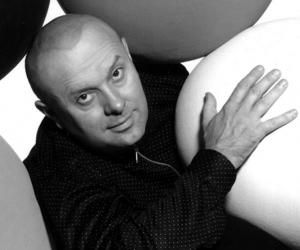First Published in
Denis Santachiara has always been an anomaly: part artist, part imaginatrix and part magician.... he's hard to categorise. Somewhat of a design enigma, it is hardly surprising that he is not immediately ranked as a proponent of "environmentally-friendly" design. The more so, because his work is not self-consciously green, neither does greening the planet appear to be on his immediate agenda. So why claim him as one of the pre-eminent eco designers of our time, then?
Because his forward-thinking designs will, in not too distant decades, validate him as an early prophet. What we design, how we design it, and how we make it, will be radically affected as population density increases and materials dwindle. Single-space living is not merely a trend, it is already a necessity - and one which will only become more prevalent. Modernity will entail not only disposing of waste responsibly, but also of wasted space. With the global population predicted to escalate to 20 billion by the year 2050, human habitations that stretch over more than one dwelling space will become the mark of the extremely affluent and the irresponsible.
Space-saving designs, which combine more than one purpose in a single object, will thrive. Such multi-functional furniture, or "functionoid design" as he calls it, is already one of Santachiara's trademarks, and has been for many years. How he began to produce items such as a rotating ventilator blade that illuminates simultaneously and armchairs that conveniently stretch into three seaters, thanks to elasticized materials, has everything to do with the way his career and interests have unfolded.
Now based in Milan, he started out as a youngster in a small Italian village where the surrounds were predominated by luxury car manufacturers like Ferrari and Lamborghini. He was born in 1950 and, as a teen, the act of designing sports cars was unavoidable. From there, he entered the art world, showing at the 1979 Venice Biennale. Several substantial international art exhibitions - Milan Triennale, Documenta - followed.
At that stage "the design world was still taken with 'good' Italian design," he explains, "but my interest was in radical design." Santachiara dedicated his investigations to emerging materials and to considering the possibilities of new technologies, spending much of his time on special projects and prototypes: "Reference to new technology became a source of inspiration throughout my career."
Back then, in the late 1970s and early 1980s, he introduced new concepts to design, like adding a performing aspect to objects, believing that they became more intelligent if they could perform, or do tasks. "New technology allowed me to follow the strategy of the magician: In the past, in mechanical objects, cause and effect would coincide. When we saw a mechanical machine, we would also see its cause. In new technology, in electronics for example, cause and effect are far apart. The effect often hides the cause. This is similar to a magic show where the magician uses technology to hide the mechanism and to only show the effect - the magic."
This is the "magic" that Denis brings to his functionoid designs; he no longer inhabits a world where form is necessarily related to function. "Unlike in old design it is no longer an issue… In the past, mechanical tools were distinctly separated from objects that satisfied an emotion in our souls. With new technology, these two aspects co-exist in a functionoid object. A computer is a typical example. We can use it as a tool and for entertainment."
Lured by the mystique of technology, by its "artificial ecstasy" as he describes it, this designer continued to explore the way in which new materials and methods could intersect with the everyday. In the late '80s an interactive lamp that switches on and off as you move it (acquired by the New York MOMA) was born, along with "chairs that have a soul" - that change colour when you sit on them, or blush if you talk too loudly… "Household furniture" he declares, "should be magical, poetic and also funny." Which is possibly what moved him to create an entirely artificial garden - replete with its own simulated storm boasting fake lightning bolts.
But the sham probably has more to do with his desire to investigate "technologies that don't belong in the world of design." This desire has led him to insert emergency bags inside simple pouf stools, and incorporate filters that hail from the aviation industry as textiles.
Of special interest are his "energy-saving" door handles that are impregnated with fluoride. They absorb light during the day only to fluoresce in the dark (no more things that go bump in the night). Then there are his couches that transform into tent-like camping beds, much to the delight of kids; and of course, his mobile lamps that don't require electrical wiring because they work off a generator.
He likes to inject an element of "surprise" into the conventional domestic appliance, irked by the fact that "normally, when you don't use it, it is just a dead object. Here the idea is that when you don't use it, it creates décor in the house." His ceiling fan-cum-designer lamp mentioned earlier is a prime example of the above. It's also a problem-solving triumph that houses two functions in one beautiful casing. Perfect for one-room homes.
Speaking of beautiful casings, even more recently the designer has managed to mimic the soft billows of clouds. His diaphanous, floating forms range from 1m to 3m in length and not only look convincing, they also simulate the slow organic motion of clouds. "If you film a cloud and then speed up your video - you'll see this cloud demonstrating the same kind of movement," he explains.
The texture, form and movement of these techno-poetic, cumuli-like objects would have sufficed to make them interesting contemplations of the natural environment. But the real coup here? These puffy clouds that waft across your living space are actually lamps, electrical appliances that bring the inspiration of nature into the home in a new and astounding way. "I believe that objects can be made alive," Denis says simply. And with results like this, who cares if it's only smoke and mirrors?
About Denis Santachiara
This multiple award-winning design giant has held numerous shows and his work forms part of permanent exhibitions in the New York MOMA, Musée des Arts Decoratives du Louvre, National Museum of Modern Arts of Tokyo, Museum of Lyon, Museum of Frankfurt, Vitra Museum of Weil-am-Rhein (Germany), the Philadelphia Museum of Art, Collection de Design du Centre Pompidou, and the Museum of Design, Triennale di Milano.















